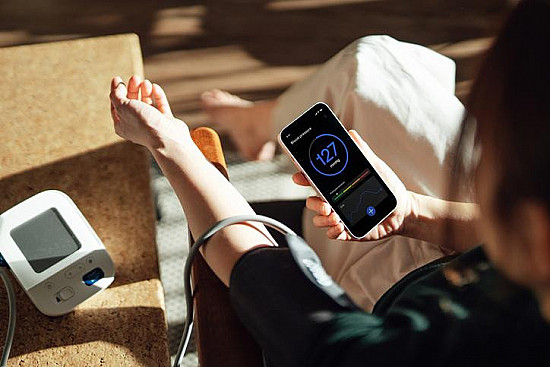Midlife pressure surge
High blood pressure becomes increasingly common among women in our 50s and beyond. Find out why.
- Reviewed by Toni Golen, MD, Editor in Chief, Harvard Women's Health Watch; Editorial Advisory Board Member, Harvard Health Publishing; Contributor

Women face a veritable pressure cooker of changes at midlife, including an emptying nest, peak job responsibilities, aging parents, and menopause. But there’s another pressure shift that also deserves our attention: far higher risk of developing high blood pressure, dubbed a “silent killer” since it usually doesn’t cause any symptoms.
Known medically as hypertension, high blood pressure means that blood pushes against artery walls with more force than normal. The condition is defined as a reading of 130/80 millimeters of mercury (mm Hg) and higher, and it increases the risks for heart attack, stroke, kidney disease, vision trouble, and many other serious problems.
It’s a big concern for both sexes: nearly half of American adults have high blood pressure, according to the CDC. But while women’s blood pressure is typically lower than men’s through our 50s, we “catch up” to men around age 60 and experience similar rates. An estimated 41% of women develop high blood pressure after menopause — almost double the prevalence among women before that life stage, according to a study published in the August 2024 issue of Current Heart Failure Reports.
But the danger can sneak up on women, Harvard experts say — and reasons for the surge aren’t always obvious.
“The general rule of thumb is that women tend to develop cardiovascular disease 10 years after their male peers. You see that for high blood pressure, too,” says Dr. Jennifer Cluett, a primary care doctor at Harvard-affiliated Beth Israel Deaconess Medical Center. “Because blood pressure typically rises with age, people whose blood pressure has always been fine are often surprised that it’s suddenly high.”
Factors increasing women’s risk
Here’s what happens at midlife that increases women’s risk of high blood pressure:
Menopause. Regardless of gender, people’s arteries gradually stiffen as we get older. But before menopause, estrogen inhibits the development of atherosclerosis (the buildup of plaque in the arteries). That protective effect diminishes in lockstep with the hormone as we move through menopause.
“Estrogen improves the dilation of blood vessels and inhibits inflammation,” Dr. Cluett says. “So the drop in estrogen further contributes to the normal age-related rise in blood pressure.”
Elevated sympathetic nerve activity. Our sympathetic nervous system governs our “fight or flight” response, which prepares us for action in dangerous situations. But at midlife, women’s sympathetic nervous system activity is higher than men’s. While some of this system’s effects can be useful, others decidedly aren’t.
“The fact that women have higher sympathetic nervous system activity makes sense in that it’s another long-term contributing factor to high blood pressure,” says Dr. Cara Guardino, a cardiologist at Harvard-affiliated Mount Auburn Hospital.
Weight gain and redistribution. Both sexes are prone to gaining weight at midlife, as we gradually lose muscle mass and burn fewer calories. But women’s estrogen loss also fuels a weight shift, with more fat deposited around the belly. Both of these are risk factors for high blood pressure.
“There are definitely metabolic changes that happen at midlife that can contribute to weight gain and what we call central obesity — fat gain around the midsection,” Dr. Cluett says. “That can raise cardiovascular risk.”
Stress. Amid all our midlife transitions, there’s much we can’t control. The accompanying stress can translate to higher levels of the hormone cortisol, which can ramp up blood pressure by narrowing blood vessels.
“We know that stress increases heart rate and causes blood vessels to constrict,” Dr. Cluett says. “When it’s chronic, this can cause a more sustained, elevated blood pressure. It’s a big factor.”
Heredity. Our genetic risks don’t “happen” at midlife, but it’s a time they’re likelier to catch up with us. It’s clear that someone’s propensity for high blood pressure can be inherited, with genes also influencing blood vessel elasticity and other contributors, Harvard experts say.
Certain genetic conditions can also greatly raise the odds of high blood pressure, Dr. Cluett notes. “I encourage people who have a family history of hypertension at an unusually young age or complications of it — like strokes in their 40s — to ask about screening for conditions that may be driving their high blood pressure,” she says.
High blood pressure isn’t inevitableWhile the odds of developing high blood pressure stack up in middle age, there’s much we can do to offset the risk. Harvard experts suggest these tactics: Exercise. Major health organizations recommend getting at least 150 minutes of moderate-to-high-intensity exercise each week. This might include brisk walking, swimming, biking, and gardening. “Just walking itself has been shown to decrease high blood pressure in the long term,” says Dr. Cara Guardino, a cardiologist at Mount Auburn Hospital. “We really try to emphasize making it a routine.” Limit alcohol. Women shouldn’t drink more than one alcoholic beverage each day, Dr. Guardino says, since drinking can influence blood pressure. “In the past, it was believed that alcohol had some protective effects on the heart,” she says, “but more recent data have shown it can increase the risk of various conditions, including high blood pressure and other forms of cardiovascular disease.” Cut salt intake. Salt is added to many foods during processing or preparation. The World Health Organization recommends consuming no more than 2,000 milligrams per day, and that amount should be lower for people who already have high blood pressure. “It’s remarkable to me when patients tell me they started reading labels and did not realize how much salt is hidden in foods,” Dr. Guardino says. Dr. Jennifer Cluett, a primary care doctor at Beth Israel Deaconess Medical Center, concurs. “Read labels, look at serving sizes, and prioritize eating foods that don’t need labels, like fresh fruits and vegetables,” Dr. Cluett advises. Control your weight. Being overweight adds to the likelihood of developing high blood pressure, and dropping extra pounds can substantially lower blood pressure. “Getting to your high school or wedding day weight is less important than shooting for gradual, sustainable changes,” Dr. Cluett says. Don’t smoke. Tobacco use constricts blood vessels, making quitting — or better yet, never starting — one of the best ways to avoid high blood pressure. Prioritize sleep. Evidence shows that insufficient sleep, defined as less than seven hours each night, increases the risk of high blood pressure, Dr. Guardino says. Combat stress. Meditation, journaling, yoga, tai chi, and psychotherapy are all effective stress-busting approaches. But one person’s idea of stress reduction may look very different from another’s. “Some people find joining a knitting group to be a great stress reducer. Volunteering can also lower stress,” Dr. Cluett says. “It depends on what brings joy to each person.” |
Image: © Jacob Wackerhausen/Getty Images
About the Author

Maureen Salamon, Executive Editor, Harvard Women's Health Watch
About the Reviewer

Toni Golen, MD, Editor in Chief, Harvard Women's Health Watch; Editorial Advisory Board Member, Harvard Health Publishing; Contributor
Disclaimer:
As a service to our readers, Harvard Health Publishing provides access to our library of archived content. Please note the date of last review or update on all articles.
No content on this site, regardless of date, should ever be used as a substitute for direct medical advice from your doctor or other qualified clinician.















